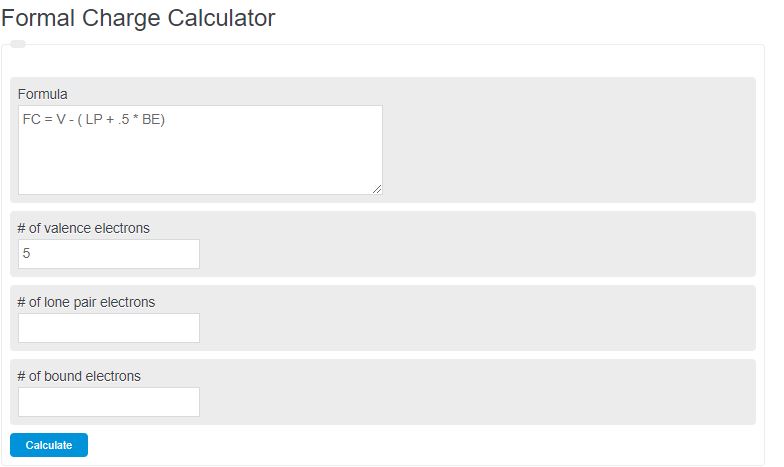Enter the total number of valence electrons, lone pairs of electrons, and the total number of bound electrons to calculate the formal charge.
- All Charge Calculators
- Moles to Atoms Calculator
- Magnetic Flux Calculator
- Photon Energy Calculator
- Discharge Calculator
Formal Charge Formula
The following equation is used to calculate the formal charge of an atom.
FC = V - ( LP +.5 * BE)
- Where FC is the formal charge
- V is the number of valence electrons
- LP is the number of lone pair electrons
- BE is the number of bound electrons
To calculate the formal change, divide the number of bound electrons by 2, add the number of lone pair electrons, then subtract this result from the number of valence electrons.
Formal Charge Definition
A formal charge is defined as the electrical charge of an individual atom.
Formal Charge Example
How to calculate a formal charge?
First, determine the number of valence electrons.
In this example, the valence electrons are found to be 3.
Next, determine the number of lone pair electrons.
in this case, the number of lone pair electrons is 1.
Next, determine the number of bound electrons.
For this problem, the number of bound electrons is 3.
Finally, calculate the formal charge using the formula above:
FC = V – ( LP +.5 * BE)
FC = 3 – ( 1 +.5 * 3)
FC = .5
FAQ
Why is calculating the formal charge of an atom important?Calculating the formal charge of an atom is crucial for understanding the distribution of electrons in a molecule, which helps in predicting the stability, reactivity, and the structure of the molecule.
Can the formal charge of an atom be negative?Yes, the formal charge of an atom can be negative, positive, or zero, depending on the difference between the number of valence electrons and the electrons assigned to the atom in the molecule.
How does the concept of formal charge relate to Lewis structures?The concept of formal charge is used in drawing Lewis structures, as it helps in determining the most stable structure of a molecule by minimizing the formal charges on atoms, ideally making them as close to zero as possible.

